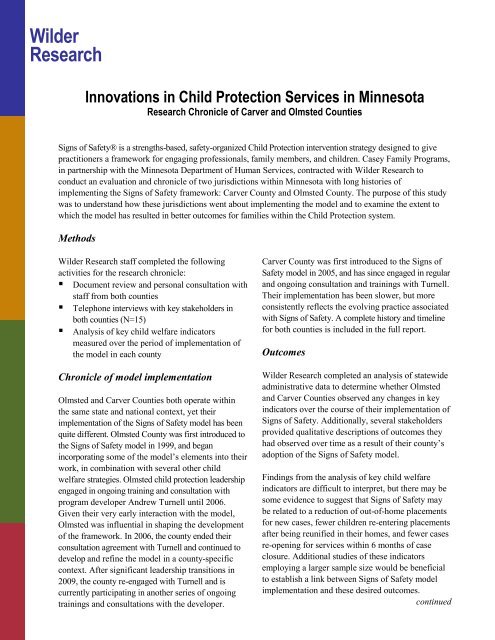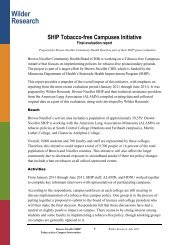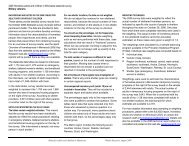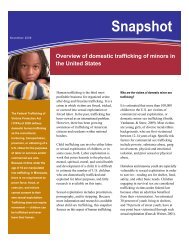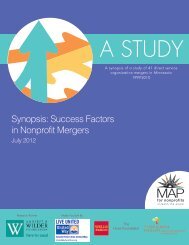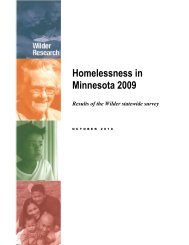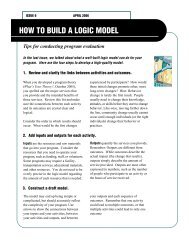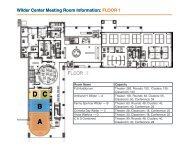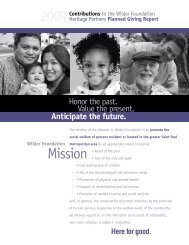Innovations in Child Protection Services in Minnesota - Research ...
Innovations in Child Protection Services in Minnesota - Research ...
Innovations in Child Protection Services in Minnesota - Research ...
You also want an ePaper? Increase the reach of your titles
YUMPU automatically turns print PDFs into web optimized ePapers that Google loves.
Wilder<br />
<strong>Research</strong><br />
<strong>Innovations</strong> <strong>in</strong> <strong>Child</strong> <strong>Protection</strong> <strong>Services</strong> <strong>in</strong> M<strong>in</strong>nesota<br />
<strong>Research</strong> Chronicle of Carver and Olmsted Counties<br />
Signs of Safety® is a strengths-based, safety-organized <strong>Child</strong> <strong>Protection</strong> <strong>in</strong>tervention strategy designed to give<br />
practitioners a framework for engag<strong>in</strong>g professionals, family members, and children. Casey Family Programs,<br />
<strong>in</strong> partnership with the M<strong>in</strong>nesota Department of Human <strong>Services</strong>, contracted with Wilder <strong>Research</strong> to<br />
conduct an evaluation and chronicle of two jurisdictions with<strong>in</strong> M<strong>in</strong>nesota with long histories of<br />
implement<strong>in</strong>g the Signs of Safety framework: Carver County and Olmsted County. The purpose of this study<br />
was to understand how these jurisdictions went about implement<strong>in</strong>g the model and to exam<strong>in</strong>e the extent to<br />
which the model has resulted <strong>in</strong> better outcomes for families with<strong>in</strong> the <strong>Child</strong> <strong>Protection</strong> system.<br />
Methods<br />
Wilder <strong>Research</strong> staff completed the follow<strong>in</strong>g<br />
activities for the research chronicle:<br />
• Document review and personal consultation with<br />
staff from both counties<br />
• Telephone <strong>in</strong>terviews with key stakeholders <strong>in</strong><br />
both counties (N=15)<br />
• Analysis of key child welfare <strong>in</strong>dicators<br />
measured over the period of implementation of<br />
the model <strong>in</strong> each county<br />
Chronicle of model implementation<br />
Olmsted and Carver Counties both operate with<strong>in</strong><br />
the same state and national context, yet their<br />
implementation of the Signs of Safety model has been<br />
quite different. Olmsted County was first <strong>in</strong>troduced to<br />
the Signs of Safety model <strong>in</strong> 1999, and began<br />
<strong>in</strong>corporat<strong>in</strong>g some of the model’s elements <strong>in</strong>to their<br />
work, <strong>in</strong> comb<strong>in</strong>ation with several other child<br />
welfare strategies. Olmsted child protection leadership<br />
engaged <strong>in</strong> ongo<strong>in</strong>g tra<strong>in</strong><strong>in</strong>g and consultation with<br />
program developer Andrew Turnell until 2006.<br />
Given their very early <strong>in</strong>teraction with the model,<br />
Olmsted was <strong>in</strong>fluential <strong>in</strong> shap<strong>in</strong>g the development<br />
of the framework. In 2006, the county ended their<br />
consultation agreement with Turnell and cont<strong>in</strong>ued to<br />
develop and ref<strong>in</strong>e the model <strong>in</strong> a county-specific<br />
context. After significant leadership transitions <strong>in</strong><br />
2009, the county re-engaged with Turnell and is<br />
currently participat<strong>in</strong>g <strong>in</strong> another series of ongo<strong>in</strong>g<br />
tra<strong>in</strong><strong>in</strong>gs and consultations with the developer.<br />
Carver County was first <strong>in</strong>troduced to the Signs of<br />
Safety model <strong>in</strong> 2005, and has s<strong>in</strong>ce engaged <strong>in</strong> regular<br />
and ongo<strong>in</strong>g consultation and tra<strong>in</strong><strong>in</strong>gs with Turnell.<br />
Their implementation has been slower, but more<br />
consistently reflects the evolv<strong>in</strong>g practice associated<br />
with Signs of Safety. A complete history and timel<strong>in</strong>e<br />
for both counties is <strong>in</strong>cluded <strong>in</strong> the full report.<br />
Outcomes<br />
Wilder <strong>Research</strong> completed an analysis of statewide<br />
adm<strong>in</strong>istrative data to determ<strong>in</strong>e whether Olmsted<br />
and Carver Counties observed any changes <strong>in</strong> key<br />
<strong>in</strong>dicators over the course of their implementation of<br />
Signs of Safety. Additionally, several stakeholders<br />
provided qualitative descriptions of outcomes they<br />
had observed over time as a result of their county’s<br />
adoption of the Signs of Safety model.<br />
F<strong>in</strong>d<strong>in</strong>gs from the analysis of key child welfare<br />
<strong>in</strong>dicators are difficult to <strong>in</strong>terpret, but there may be<br />
some evidence to suggest that Signs of Safety may<br />
be related to a reduction of out-of-home placements<br />
for new cases, fewer children re-enter<strong>in</strong>g placements<br />
after be<strong>in</strong>g reunified <strong>in</strong> their homes, and fewer cases<br />
re-open<strong>in</strong>g for services with<strong>in</strong> 6 months of case<br />
closure. Additional studies of these <strong>in</strong>dicators<br />
employ<strong>in</strong>g a larger sample size would be beneficial<br />
to establish a l<strong>in</strong>k between Signs of Safety model<br />
implementation and these desired outcomes.<br />
cont<strong>in</strong>ued
Wilder <strong>Research</strong> staff also spoke with 15 stakeholders<br />
from Olmsted (N=8) and Carver (N=7) Counties.<br />
Stakeholders were identified by county staff as<br />
<strong>in</strong>dividuals who had at least 10 years of experience<br />
work<strong>in</strong>g with the county’s <strong>Child</strong> <strong>Protection</strong> system,<br />
but who were not child protection staff (e.g., attorneys,<br />
judges, doctors, law enforcement, school staff,<br />
Guardians ad Litem). Through the course of their<br />
<strong>in</strong>terviews, stakeholders identified a number of<br />
changes they had observed over the past 10 years with<br />
regard to their county’s child protection system <strong>in</strong><br />
general, and, where relevant, the <strong>in</strong>troduction of Signs<br />
of Safety. These changes, identified below, are<br />
described <strong>in</strong> detail <strong>in</strong> the full report.<br />
• Increased or improved collaboration with their<br />
county’s <strong>Child</strong> <strong>Protection</strong> department<br />
• Increased family <strong>in</strong>volvement <strong>in</strong> identify<strong>in</strong>g<br />
solutions to improve safety for children<br />
• Greater transparency with and respect for families<br />
• Implementation of safety networks (family,<br />
friends, and neighbors) to provide a support<br />
system for families<br />
• More organization, efficiency, and<br />
standardization <strong>in</strong> child welfare practices<br />
• Increased use of evidence-based or researchdriven<br />
practices<br />
• Better outcomes for families: lower recidivism,<br />
<strong>in</strong>creased safety and permanency<br />
Dur<strong>in</strong>g their <strong>in</strong>terviews, stakeholders also identified<br />
several concerns about the Signs of Safety model:<br />
• Overemphasis on keep<strong>in</strong>g children with their<br />
families, sometimes at the expense of their safety<br />
• Ineffectiveness <strong>in</strong> address<strong>in</strong>g chronic neglect cases<br />
• Unknown or unclear consequences for children<br />
or families who do not follow-through on plans<br />
• Difficulty <strong>in</strong> ma<strong>in</strong>ta<strong>in</strong><strong>in</strong>g rigor and discipl<strong>in</strong>e to<br />
the model among workers<br />
• Uncerta<strong>in</strong>ty about the stability of safety<br />
networks after case closure<br />
• Inability for workers to ma<strong>in</strong>ta<strong>in</strong> objectivity <strong>in</strong><br />
identify<strong>in</strong>g concerns about parents<br />
Implications for other jurisdictions<br />
consider<strong>in</strong>g Signs of Safety<br />
Several lessons emerged from the chronicl<strong>in</strong>g of<br />
child welfare outcomes <strong>in</strong> Carver and Olmsted<br />
Counties and their experiences with Signs of Safety.<br />
It may be helpful for jurisdictions consider<strong>in</strong>g<br />
implement<strong>in</strong>g the Signs of Safety approach to take<br />
<strong>in</strong>to account the follow<strong>in</strong>g implications:<br />
• Implement<strong>in</strong>g Signs of Safety is a culture<br />
change for agencies. Signs of Safety is a<br />
culture change <strong>in</strong> child protective practice and,<br />
as such, it is important to keep <strong>in</strong> m<strong>in</strong>d that the<br />
model takes time to implement, it works better<br />
by attract<strong>in</strong>g rather than mandat<strong>in</strong>g workers to<br />
participate, it changes the agreed upon ways of<br />
do<strong>in</strong>g th<strong>in</strong>gs, and it has implications for the<br />
other service systems it touches. How have<br />
county or state agencies that implemented new<br />
practice approaches through a mandate been<br />
successful with Signs of Safety?<br />
• More education about Signs of Safety is needed,<br />
especially for social workers, to improve<br />
consistency <strong>in</strong> practice. This education and<br />
tra<strong>in</strong><strong>in</strong>g could extend to partners <strong>in</strong> other systems<br />
(e.g., courts, schools, public health) to ensure<br />
consistency across systems for families. Partners<br />
who have a better understand<strong>in</strong>g of the model<br />
may be more likely to support the decisions<br />
made by the worker and family.<br />
• Flexibility is important; the model will not<br />
look the same across all jurisdictions. Because<br />
each county is different – with different histories,<br />
leaders, and practices – potential implementers<br />
of Signs of Safety must be will<strong>in</strong>g to be flexible;<br />
for Signs of Safety to be successful <strong>in</strong> a specific<br />
jurisdiction, leaders must be will<strong>in</strong>g to adapt the<br />
model, as needed, to their local context. This<br />
<strong>in</strong>cludes consider<strong>in</strong>g the pace of implementation,<br />
and the voluntary/mandatory nature of <strong>in</strong>troduc<strong>in</strong>g<br />
the model to workers and supervisors.<br />
• Jurisdiction leadership has an impact on the<br />
implementation of Signs of Safety. Differences<br />
<strong>in</strong> leadership style appear to not only <strong>in</strong>fluence<br />
the <strong>in</strong>itial adoption and implementation of the<br />
model by workers and external stakeholders, but<br />
also impact the model’s susta<strong>in</strong>ed change and
growth. Although there have not been any major<br />
changes <strong>in</strong> leadership <strong>in</strong> Carver, it seems less<br />
likely that a leadership transition would have a<br />
significant impact on susta<strong>in</strong><strong>in</strong>g Signs of Safety<br />
-- given their <strong>in</strong>itial approach to implementation,<br />
and process for obta<strong>in</strong><strong>in</strong>g buy-<strong>in</strong> from workers<br />
and supervisors.<br />
• Disputes about the orig<strong>in</strong>ality of Signs of<br />
Safety may be moot. While there may be<br />
disagreement about the orig<strong>in</strong>ality or orig<strong>in</strong>s of<br />
the ideas presented <strong>in</strong> Signs of Safety, it is clear<br />
that Signs of Safety, <strong>in</strong> general, and Andrew<br />
Turnell, <strong>in</strong> particular, have a way of energiz<strong>in</strong>g<br />
child welfare workers – such as gett<strong>in</strong>g them to<br />
th<strong>in</strong>k critically about their work and encourag<strong>in</strong>g<br />
them to practice differently. This may be effective<br />
precisely because Andrew Turnell is a relative<br />
“outsider” to the agency. He is also a charismatic<br />
speaker, and skillfully packages and markets his<br />
product. While some feel that Signs of Safety is<br />
simply reword<strong>in</strong>g practices that were already<br />
available elsewhere or <strong>in</strong> place, others argue that<br />
“packag<strong>in</strong>g” <strong>in</strong>tervention strategies is a good<br />
way to standardize child welfare practices and<br />
make them more accessible for everyone.<br />
• There are no silver bullets. Families <strong>in</strong> the <strong>Child</strong><br />
<strong>Protection</strong> system, and the challenges they face,<br />
are complex and not easily “solved.” While Signs<br />
of Safety is a valuable and important practice, it is<br />
not a cure-all. Perhaps the real value of Signs of<br />
Safety is <strong>in</strong> the <strong>in</strong>teraction with families. For<br />
example, as one stakeholder noted, although the<br />
outcomes <strong>in</strong> some cases might be the same as<br />
before Signs of Safety (such as a Term<strong>in</strong>ation of<br />
Parental Rights), there are fewer nasty court<br />
battles. Now, families, workers, and judges reach<br />
an amicable agreement based on a mutual<br />
understand<strong>in</strong>g of the best <strong>in</strong>terests of the child.<br />
Wilder<br />
<strong>Research</strong><br />
Information. Insight. Impact.<br />
451 Lex<strong>in</strong>gton Parkway North<br />
Sa<strong>in</strong>t Paul, M<strong>in</strong>nesota 55104<br />
651-280-2700<br />
www.wilderresearch.org<br />
For more <strong>in</strong>formation<br />
This summary presents highlights of the <strong>Innovations</strong> <strong>in</strong> <strong>Child</strong> <strong>Protection</strong><br />
<strong>Services</strong> <strong>in</strong> M<strong>in</strong>nesota Report. For more <strong>in</strong>formation about this report,<br />
contact Monica Idzelis Rothe at Wilder <strong>Research</strong>, 651-280-2657.<br />
Authors: Monica Idzelis Rothe, Stephanie Nelson-Dusek,<br />
and Maggie Skrypek<br />
JANUARY 2013


